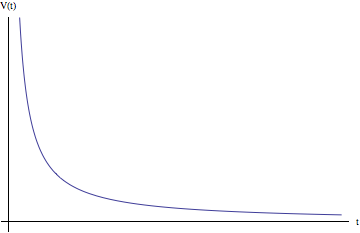Using Griffiths Example 10.3 as a roadmap, I’ve attempted to derive an equation describing the electric potential due to a point charge moving in uniform circular motion. My complete derivation (available here) is too long to post in its entirety, but I’ve outlined it below. It relies heavily on vector algebra, and on a few equations from Griffiths.
First I express a uniform circular trajectory in spherical coordinates:
(1) ![]()
Then I use Griffiths 10.33 to find an expression for the retarded time. This requires solving the quadratic function in $t_r$, and then making a few clever comparisons (see the full proof) to obtain the correct solution sign. In the end it comes out to be:
(2) ![]()
Where I’ve let the $\clubsuit = (c^2-w^2)$ in order to have the equation fit on the page.
I then use Griffiths 10.33 and 10.34 to obtain expressions for the script r vector. In particular, I find a useful expression for the denominator of the Liénard-Wiechert electric potential:
(3) ![]()
Where $t_r$ is defined by equation (2) above. This allows for a substitution directly into the Liénard-Wiechert potential equation (Griffiths 10.39):
(4) ![]()
Here I’ve refrained from substituting in for $t_r$ in the interest of space. I’ve created some Mathematica code to plot this derived expression for the electric potential, but I had difficulties exporting it. A quick look at the code reveals why: there are two large regions where the value of the potential is indeterminate. I’m unable to come up with a physical explanation for this, but a mathematical one follows quickly from a look at the denominator of the potential function. Essentially the problem is there exist values of $r$, $\phi$, and $t$ that allows the radicand to become negative, which results in a complex value for the potential. Taking the absolute value does eliminate this problem, but the physical motivation for making such a move is unclear.
As far as the function itself goes, it makes me wonder if there’s not some mistake in my derivation. There are aspects of the physical situation that I feel it models well: the spiral shape, the smoothness near points of maximum potential; for a idea of why the spiral shape is accurate, check out this article, particularly Figure 1 (J.H Hannay, M.R Jeffrey). But the problems are glaring. For one thing, the function isn’t periodic- it drops off to zero for large values of t. Our particle is moving in uniform circular motion, so the resulting potential should reflect that by oscillating as well. The indeterminate regions I mentioned above are also a problem – the electric potential should be defined all regions of the coordinate system. The other issue is that the arms of the spiral cease abruptly after a certain radius- there should be a gradual decrease in potential for larger and larger values of r.
I was able to fix a Mathematica problem that I mentioned in the Preliminary section. One of my animations was exhibiting a suspicious asymmetry, which I discovered was due to an idiosyncrasy of Mathematica’s evaluation. The fixed video is below. It represents the potential due to a point that begins at rest at the origin and moves along the $z$ axis with constant velocity.
http://www.youtube.com/watch?v=OrgqJrLflME&feature=youtu.be


![Rendered by QuickLaTeX.com \begin{equation*} V = \frac{qc}{\sqrt{\left(c^2t-\frac{vz\sqrt{x^2+y^2+z^2}}{x^2+y^2+z^2}\right)^2 +\left(c^2-v^2\right)\left(x^2+y^2+z^2-c^2t^2\right)\right]}} \end{equation*}](https://pages.vassar.edu/magnes/wp-content/ql-cache/quicklatex.com-bb03d4a473db4f0166ae6687bb56e5f7_l3.png)
